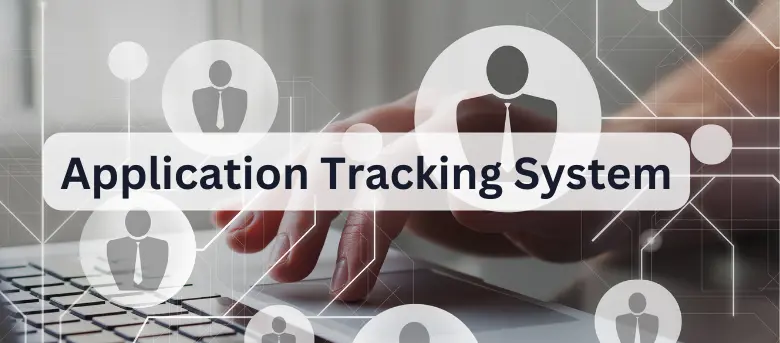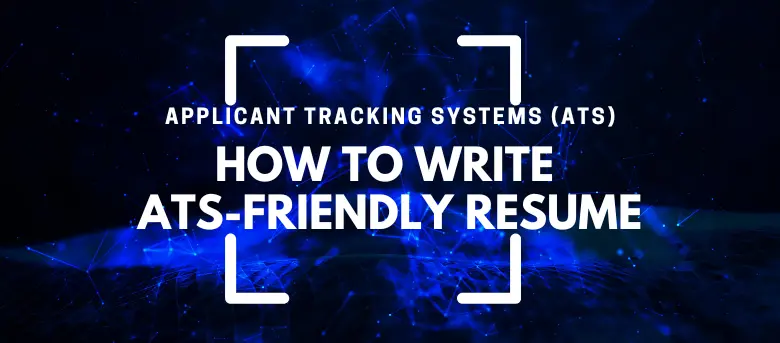In today’s competitive job market, submitting a job application online is a common way to apply for jobs. However, many job seekers are unaware of the Applicant Tracking Systems (ATS) used by employers to screen and filter resumes before a human ever sees them. An ATS is a software system designed to organize, sort, and filter job applications based on specific criteria such as keywords, qualifications, and work experience.
ATS software can be a game-changer for employers, but it also challenges job seekers who want to make a good impression. To increase your chances of getting your foot in the door, your resume should be written in a way that is easy for ATS software to read and understand. By doing so, you’ll be able to bypass the gatekeepers and land your dream job.
This guide will provide step-by-step instructions on how to write an optimised ATS resume in 2024. It will cover everything from understanding ATS to analyzing job descriptions, formatting your CV, using ATS-friendly language, optimizing keywords and phrases, ATS resume templates and checking for errors. By following the tips and strategies outlined in this guide, you can increase your chances of getting past the ATS scan and landing an interview.
Understanding Applicant Tracking Systems (ATS)
A. How ATS Software works
ATS software is designed to scan, sort, and rank resumes based on specific criteria set by the employer. The software will look for keywords and phrases that match the job description and qualifications required for the position. The software will then rank the CVs based on how closely they match the criteria, with the highest-ranked resumes being the ones that are most likely to be reviewed by a human recruiter.
B. How to make your resume ATS-friendly
Ensure that the software can read and parse your resume accurately. This means using a well-structured CV with clear headings, bullet points, and a consistent layout. You should also use standard fonts such as Times New Roman or Arial, and avoid using graphics, images, or tables as these can confuse the software.
C. The importance of a well-structured resume
The Applicant Tracking System is designed to look for specific information in your resume, such as your work experience, education, and skills. By using a clear and concise structure, you can make it easier for the software to find the information it needs, increasing your chances of being ranked higher in the system.
Additionally, a well-structured CV is also important for human recruiters. A cluttered or poorly formatted resume can be difficult to read and may turn off recruiters, even if it passes the ATS. By presenting your information clearly and concisely, you can make it easier for recruiters to see your education and skills, increasing your chances of getting an interview.
Analyzing Job Descriptions
When applying for a job, it is important to carefully analyze the job description and tailor your Curriculum vitae accordingly. This means identifying specific keywords and phrases that the employer is looking for and making sure your resume highlights your relevant skills and experiences.
Identifying relevant keywords and phrases
One of the most important things to do when analyzing a job description is to identify keywords and phrases. These are the words and phrases that the employer is looking for in a candidate. Look for keywords related to the job title, required education, and specific skills mentioned in the job description. These keywords can be used to optimize your resume for the ATS system and make sure that it gets noticed by the employer.
Understanding the Job Requirements
Understanding the job requirements is crucial when tailoring your CV to a job specification. Make sure you understand what the job entails, the required skills and education, and the type of candidate the employer is looking for. This information will help you customize your resume to the job requirements and increase your chances of getting hired.
Highlighting your relevant skills and experiences
Once you have identified the relevant keywords and have a good understanding of the job requirements, you can then highlight your relevant skills and experiences on your resume. Use bullet points to list your accomplishments, and make sure to quantify your achievements whenever possible.
How to Tailor Your Resume To The Job Listing
Begin by incorporating the same language and keywords found in the job description to enhance the visibility of your CV. Ensure that your Curriculum Vitae is reader-friendly, with a focus on highlighting your pertinent skills and experiences. Additionally, prioritize customizing your resume for the particular job you are seeking, avoiding the use of a generic CV for all applications. For valuable tips on crafting an impactful CV tailored to the Dubai job market, refer to these insightful ‘CV writing tips‘

ATS-Friendly Resume Format
Choosing the Right Format for Your Resume
When it comes to formatting your resume for ATS, choosing the right format is key. But with so many options out there, how do you know which one is right for you?
There are three main types of resume formats:
- Chronological: A chronological resume is great for job seekers with a steady work history and a clear career path, as it lists your work experience in reverse chronological order, starting with your most recent job.
- Functional: If you have gaps in your employment history or are changing careers, a functional resume might be a better choice. This format emphasizes your skills and achievements rather than your work experience, making it easier to showcase your strengths.
- Combination: If you have gaps in your employment history or are changing careers, a functional resume might be a better choice. This format emphasizes your skills and achievements rather than your work experience, making it easier to showcase your strengths.
ATS-friendly Resume Templates
If you want to increase your chances of getting your resume seen by a human recruiter, using an ATS-friendly resume template can be a game-changer. These templates are designed to help you create a visually appealing and easy-to-read resume that complies with ATS requirements.
ATS-friendly resume templates use clear and easy-to-read fonts, and they are structured to make your resume easy to scan. They provide ample space for your contact information, work experience, skills, and education in the correct order. With an ATS-friendly resume template, you can be sure that your resume is formatted correctly and optimized for the ATS, giving you the best chance of landing an interview.
Optimizing your Resume for Readability
When it comes to creating an ATS-compliant resume, readability is key. Your resume should be easy to scan, with clear section headers and bullet points that make it easy to read quickly. Use a font size of at least 11 or 12 points and stick to standard fonts like Arial or Times New Roman.
Avoid using graphics, tables, or images that could confuse the ATS. Instead, use simple bullet points to highlight your achievements and skills. Keep your resume to two pages or less and use white space to make it easy on the eyes.
Customizing your Resume for Specific Job Listings
One of the most important things you can do to create an ATS resume is to customize it for each job you apply to. That means analyzing the job description, identifying keywords and phrases, and tailoring your resume to match.
Use the same language and terminology used in the job specification, highlighting your relevant skills and experiences. Be sure to include any specific educational or certifications required for the job, and use the job title in your resume header or summary.
By customizing your resume for each job, you not only increase your chances of getting your resume past ATS, but you also show the hiring manager that you are the perfect candidate for the job.
Using ATS-Friendly Language

Here are some tips for using language that is optimized for ATS:
Writing in plain language
While it’s important to showcase your skills and experience, you should also strive to write in plain language. Avoid using complex vocabulary or convoluted sentence structures. Instead, use simple, straightforward language to make your points clear and easy to understand.
Avoiding industry-specific jargon
While it might be tempting to use industry-specific jargon and acronyms to showcase your expertise, these terms can actually hinder your chances of passing through an ATS. That’s because not all resume scanners are programmed to recognize these terms, and they might flag them as irrelevant.
Emphasizing your qualifications and experience
To make your CV stand out, you need to emphasize your qualifications and experience. Use strong action verbs to describe your accomplishments and highlight the specific skills you bring to the table.
Keeping your resume easy to read and scan
Finally, it’s important to keep your resume easy to read and scan. Use bullet points to break up long blocks of text, and keep your sentences short. Use clear section headings and subheadings to organize your content and make it easy for the ATS to parse.
Optimizing Keywords and Phrases
Crafting the best resume for ATS requires strategic use of keywords and phrases to increase the chances of getting shortlisted for an interview. In this section, we’ll delve into the significance of incorporating relevant keywords in your resume and how to optimize them to make your resume stand out in the pool of job applications.
Identifying and using relevant keywords
One of the most important aspects of writing a resume to make it ATS optimised is identifying and using relevant keywords. These are the words and phrases that recruiters and hiring managers use to search for resumes in the Applicant Tracking System. When creating your resume, it’s important to research and analyze the job description to identify the most important keywords for that particular role.
Incorporating keywords throughout your resume
Once you’ve identified the relevant keywords, it’s important to incorporate them throughout your resume. These keywords should be used in your resume’s headline, summary, work experience, and skills sections. However, be careful not to overdo it – stuffing your resume with too many keywords can make it appear spammy and hurt your chances of getting through the Applicant Tracking System.
Avoiding keyword stuffing
Keyword stuffing is the practice of overusing keywords in an attempt to manipulate search rankings. While incorporating relevant keywords is important, it’s equally important to ensure that your resume reads naturally and flows well. Use keywords in a way that makes sense and adds value to your resume.
Importance of a Targeted Resume
Creating a targeted resume that is tailored to the specific job you’re applying for is essential to getting past the ATS. This means customizing your resume with the relevant keywords and phrases and highlighting your educational background and experience that aligns with the job requirements. A targeted resume will not only get past the ATS, but it will also make a strong impression on the recruiter or hiring manager.
Checking and Double-Checking Your CV
After you have written your resume, it’s time to review and refine it. This step is crucial as even a small error or typo can put off the recruiters, and your resume might end up in the trash. Therefore, it’s essential to take the time to proofread and edit your resume carefully.
Proofreading for errors and typos
Proofreading your resume for errors and typos is the first step in ensuring that it is error-free. Read through your resume thoroughly, looking for any spelling or grammatical errors. You can also use tools like Grammarly or Hemingway to check for errors and suggest better word choices.
Checking for grammar and formatting issues
Make sure that you have used a consistent font, size, and style throughout your resume. Use bullet points and headings to make your resume easy to read and scan.
Getting someone else to review your resume
Getting a second opinion is always a good idea. Ask a friend, family member, or colleague to review your resume and provide feedback. They might catch errors that you missed, or suggest ways to improve your resume.
Common mistakes to avoid
One of the biggest mistakes you can make is including irrelevant information. Make sure everything on your resume is relevant to the job you’re applying for and cut out anything that doesn’t support your qualifications or experience.
Another mistake is using long paragraphs. Hiring managers and Applicant Tracking Systems alike prefer short, easy-to-read sections that highlight your key skills and accomplishments.

Get Ahead with These Free ATS-Compliant Resume Templates
Using an ATS-friendly resume template is a great way to optimize your resume for applicant tracking systems. These templates are designed specifically to be easily parsed and read by the software, increasing your chances of getting through the initial screening process. There are many resources available online where you can find free ATS-friendly resume templates and resume builders. Some popular options include:
- Canva: Canva offers a wide range of free resume templates that are ATS-friendly and easy to customize.
- Hloom: Hloom has a variety of professionally designed resume templates optimized for ATS, and they are available for free download.
- Google Docs: Google Docs offers a variety of resume templates that are designed to be compatible with ATS.
- Resume.com: Resume.com offers a range of customizable resume templates that are optimized for ATS.
- Microsoft Word: Creating a CV in Microsoft Word is made easier with a range of ATS-friendly resume templates available. You can explore our guide on how to make your CV in Microsoft Word
When selecting a template, be sure to pick the best template to match the job you’re applying for, one that is easy to read and follow, and that highlights your skills, qualifications and strengths.
Frequently Asked Questions about ATS
A well-crafted and optimised resume can increase your chances of getting past the initial screening process and landing an interview. However, job seekers often have several questions about how to optimize their resumes for ATS. Below are some common FAQs about ATS and resumes:
What are ATS Compliant resumes?
An ATS-compliant resume is specifically structured and optimized to meet the requirements of an ATS. It includes the use of specific keywords and phrases, proper styling, and avoiding common errors that can cause the system to reject your resume. To help you create an ATS-compliant resume, we’ve covered everything you need to know in this blog. You’ll learn how ATS works, how to analyze job descriptions, optimise resume content, use ATS-friendly language, and optimize keywords and phrases. We’ll also show you how to check and double-check your resume for errors and typos.
How do I make sure my resume is ATS-friendly?
If you want your resume to get noticed by hiring managers, you need to make it ATS-friendly. It might sound complicated, but it’s easier than you think. Just follow these simple guidelines that we’ve outlined below. For a more detailed overview of ATS and how to optimize your CV, be sure to check out our blog!
Step 1: Take a good look at the job description and find the keywords and phrases that are most important.
Step 2: Choose a format that showcases your skills and experience in a way that the ATS software can easily read. Be sure to optimize your language and avoid stuffing too many keywords into your resume.
Step 3: Give your resume a final check and proofread for errors and typos.
By following these steps, you’ll have a resume that is designed to get noticed by ATS software and employers alike.
What resume format is ATS-friendly?
While ATS systems can read and analyze various formats, it’s best to keep it simple and clean. That means using a format that is easy for the system to parse, such as a Word document or PDF.
But wait, there’s more! To optimize your resume for ATS compatibility, it’s important to avoid using complex formatting elements. Graphics, tables, columns, and text boxes might look nice, but they can confuse the ATS and lead to incorrect parsing of your resume.
In this article, we cover everything you need to know about choosing the right format, resume keywords and optimizing your CV for ATS compatibility. We’ll show you how to create a resume that looks great and is easy for an ATS to read, so you can get past the automated screening process and into the hands of a real person.
How long should your resume be?
There is no strict rule about the length of your resume, but it is recommended to keep it concise and to the point. A one to two-page resume is ideal, highlighting your most relevant experiences, skills, and qualifications.
Can I use bullet points in my resume?
Yes, bullet points are an excellent way to organize your resume and make it easy to scan for ATS and recruiters. However, avoid using symbols or special characters, as they may not be readable by ATS.
Should you use a PDF or Word document format?
PDF is the preferred format for ATS, as it preserves the structure and style of your resume, and is generally easy to open and read. However, some ATS systems may not be able to parse text from PDF documents, so it is essential to check the job listing or company’s application guidelines to determine the preferred format before uploading your resume.
Does an ATS-friendly resume work for all job applications?
While an ATS-optimised resume can significantly increase your chances of getting past the initial screening process, it may not guarantee you a job. Some employers may use a combination of ATS and human recruiters to review resumes. Therefore, it is essential to tailor your resume to the job description, highlight your relevant qualifications, and make sure it is easy to read and scan for both humans and ATS.
Recap: ATS-Friendly Resume
In this guide, we have covered everything you need to know on how to create a perfect resume with ATS software in mind, starting from understanding what ATS is and why it is important to craft your resume with keywords, formatting, and language that meets ATS requirements.
Importance of an ATS-friendly resume:
An ATS-friendly resume increases the chances of your resume getting noticed by hiring managers and recruiters. It helps you to pass the initial screening stage and get shortlisted for the next level of review. Without an ATS-friendly resume, you could be missing out on great job opportunities.
Creating an ATS-friendly resume may seem daunting at first, but it is crucial to invest time and effort in making sure your resume is optimized for ATS. We encourage you to implement the steps discussed in this guide and start seeing results in your job search.
Final tips for job seekers to optimize their resumes for ATS:
Here are some additional tips to optimize your resume for ATS:
- Use bullet points to make it easy to scan and read.
- Avoid using graphics, images, and special characters.
- Customize your resume for each job application.
- Use relevant keywords throughout your resume.
- Keep your formatting simple and consistent.
- Proofread your resume for errors and typos.
In conclusion, an ATS-friendly resume is an essential tool for job seekers to get noticed by hiring managers and recruiters. By following the steps outlined in this guide, you can create an ATS-friendly resume that increases your chances of getting hired. Remember to tailor your resume to each job application and keep it concise and easy to read. Good luck with your job search!


